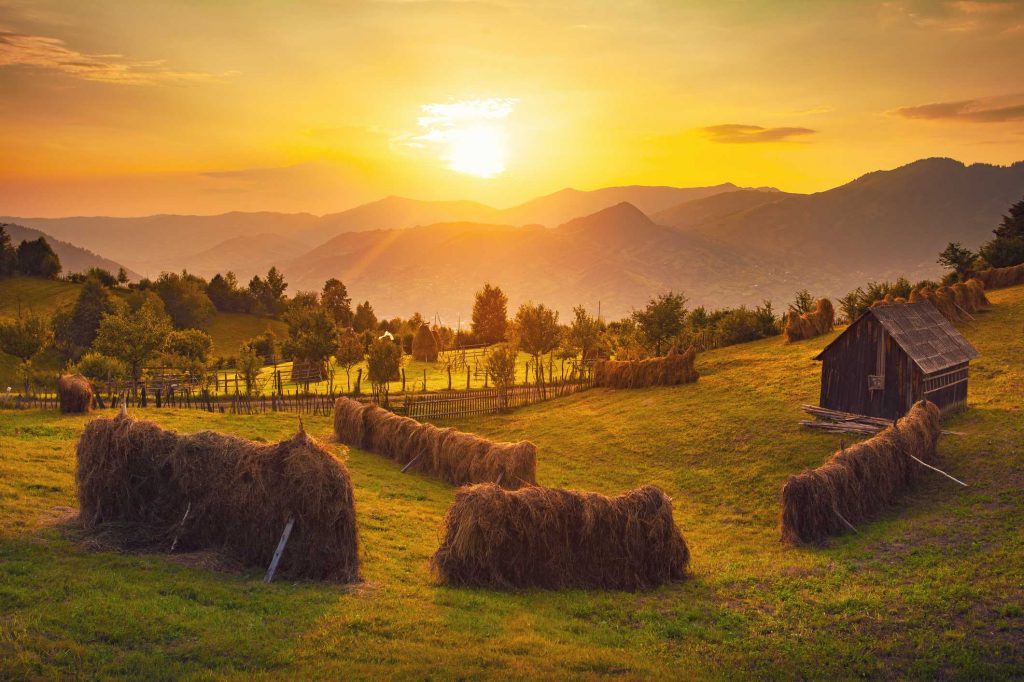Today’s journey will take us to the land of monasteries, a place rich in beauty and spirituality, but one that has experienced a turbulent history for over half a century. We will visit several Orthodox churches renowned for their vividly colored exterior frescoes that depict monumental scenes from the Bible.
Cluj Napoca
9:00 AM
The Voroneț Monastery, known as the Sistine Chapel of the East for its Last Judgment fresco, is a medieval monastic complex from the 15th century, founded by Stephen the Great and constructed in record time for that era, in just 3 months and 3 weeks. Voroneț is renowned not only for its famous blue pigment, known as Voroneț Blue, but also for its durability under harsh climatic conditions, which is why it has been included in the UNESCO World Heritage list.
The Moldovița Monastery, another monumental gem, impresses with its rich colors and the complexity of its depicted scenes. Among the most famous is the Siege of Constantinople. Notable is the blend of Byzantine and local elements, as well as the Romanian interpretation of traditionally Byzantine themes. The exterior painting prominently features the color yellow.
The Sucevița Monastery is one of the most interesting monasteries in Bucovina in terms of details, scenes, and interior painting, combining elements of Moldavian architecture with Gothic and Byzantine art. Legend has it that to atone for her sins, a woman from the village brought, with a cart drawn by buffaloes, the stone needed for the current construction over thirty years. With the appearance of a medieval fortress due to its fortified walls, Sucevița impresses with the vivid green of its exterior paintings and the richness of the painted scenes, being the only monument with the largest number of religious images in the country.
The Putna Monastery, the first foundation of Stephen the Great and a place of eternal rest, was erected on the spot where the arrow from the prince’s bow is said to have fallen, according to legend. A place full of legends and history, a pilgrimage site, and an important spiritual center, distinguished by its proportions and notable for its collections of embroidery, textiles, and liturgical objects preserved in the Monastery Museum.
The village of Marginea is renowned in the country for its unique black pottery, which is produced here, unlike any other in Europe. Black pottery is made from the four basic natural elements: earth, water, air, and fire, all readily available to the craftsmen of Marginea due to the forests, clayey soil, and water of the Sucevița River. Here, clay takes various forms: dishes, mugs, vases, and jugs, decorated with impressions directly on the wet clay and polished with flint on the dry clay.
We will uncover the mystery of this black pottery from the potter craftsmen who will reveal the manufacturing process and secrets of this craft, and we can test our artistic skills at the potter’s wheel in the workshop.
We will end the day at La Saivan, where our host will treat us to dishes prepared from traditional recipes with ingredients from their own farm.
Don’t miss the nearby La Masa Olarului restaurant, a traditional peasant house converted into a restaurant and decorated in Bucovina style. Order with confidence and enjoy your chosen dishes in traditional clay pots.
All aboard! Ready to embark? Let’s set off on a journey with the Mocănița from Moldovița – Hutulca.
The most cherished attraction in Bucovina, Mocănița, the old steam train once used for transporting timber from the forest to the sawmills, takes us on a leisurely ride through the land of the Hutsuls, the Ukrainian ethnic group. This trip is a journey back in time through their villages, in a tranquil and friendly atmosphere. We will travel 12 kilometers at a slow pace, perfect for admiring the nature and enjoying each bend. Along the way, we’ll glimpse picturesque houses surrounded by wooden fences typical of the mountainous area, scattered along the Moldovița River, orchards with haystacks, and scattered hay on the mountain valleys. At the end of the route, we will stop in a meadow at the edge of the fir forest, where we’ll be treated to a Bucovinian feast in the open air. We’ll indulge in fine dishes prepared by local hosts: from zacuscă to jams, from steaming hot meals to blueberry liqueur and cheeses. After the hearty feast, we will return to the train and continue our journey a bit longer through this fairytale setting, carrying with us precious memories and unforgettable experiences.

In the afternoon, we will visit the most renowned Egg Painting Museum and participate in a workshop organized by Ms. Letiția Orșivschi, a renowned artisan artist and creator of several exhibits in the museum, where we will learn some Bucovinian egg painting techniques.
Return to the guesthouse. Traditional dinner.
A place steeped in history and legends, the Suceava Fortress is part of the medieval fortification system built in response to the Turkish threat and was the primary residence of Moldavian rulers. The complex included fortified settlements, monasteries surrounded by high walls, princely courts, and strategic defensive fortresses.
Restored and reinforced, the fortress now presents a glimpse into Moldova’s past through modern technology. Let’s traverse the fortress and uncover the history of the region and the secrets of ancient times on a tour of this medieval stronghold, which has never been conquered.
After visiting the fortress, it’s worth spending a few moments at the Bucovinian Village Museum to admire the traditional rural households of the area, complete with taverns, wells, and churches situated along the alleys. Local crafts and trades are also represented in workshops equipped with complete inventories.
Return to the guesthouse for a traditional dinner.
